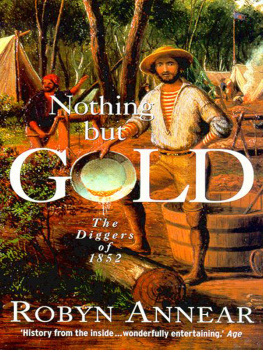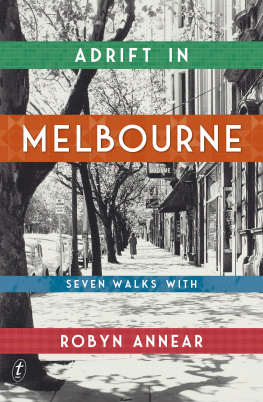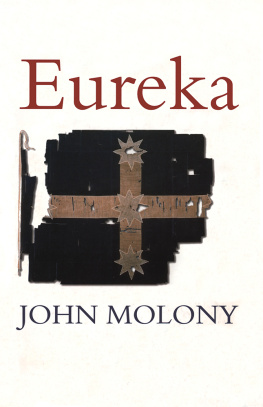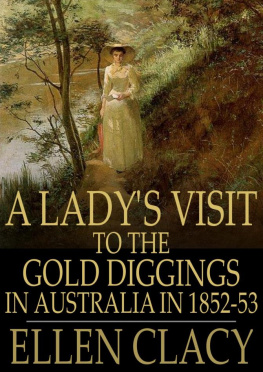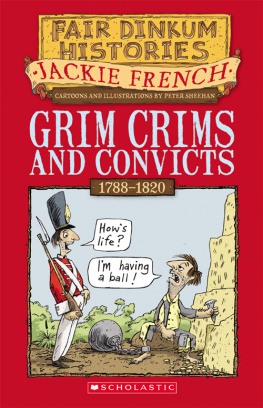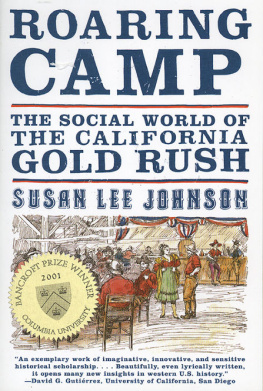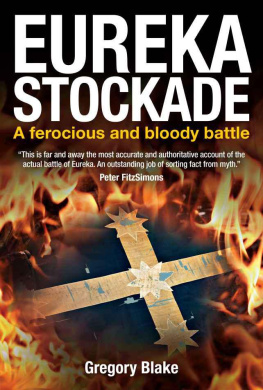
NOTHING BUT GOLD
Robyn Annears first book, Bearbrass: Imagining Early Melbourne, won the A. A. Phillips Prize for Australian Studies in the 1995 Victorian Premiers Literary Awards and was shortlisted for the 1995 New South Wales Premiers Literary Awards and the Age Book of the Year. She is a typist and lives in the Victorian goldfields with somebody elses husband.
The Text Publishing Company
Melbourne Victoria 3000
Australia
Copyright Robyn Annear 1999
All rights reserved. Without limiting the rights under copyright above, no part of this publication shall be reproduced, stored in or introduced into a retrieval system, or transmitted in any form or by any means (electronic, mechanical, photocopying, recording or otherwise), without the prior permission of both the copyright owner and the publisher of this book.
First published 1999
This edition 1999; reprinted 2008
Designed by Chong Weng-ho
Typeset by J & M Typesetting
National Library of Australia
Cataloguing-in-Publication data:
Annear, Robyn.
Nothing but gold: the diggers of 1852.
Includes index.
ISBN
1. Gold miners - Victoria - History. 2. Victoria - Gold discoveries. I. Title. 994.5031
This project has been assisted by the Commonwealth Government through the Australia Council, its arts funding and advisory body.
Front cover, I have got it, Eugne von Gurard, painting, 1854, courtesy LaTrobe Picture Collection, State Library of Victoria;
Chapters 3 and 21, New Chums, Refreshing sleep and The Gold Commissioners Tent, Near Golden Point, Ballaarat, from William Strutts, Victoria the Golden Scenes Sketches and Jottings from Nature 1850-1862, reproduced with the permission of the Library Committee of the Parliament of Victoria;
Chapter 4, Oh! My Goodness Gracious, Ill Be offHold on, Poll my girl all right, George Lacy, watercolour (R3803), courtesy National Library of Australia;
Chapters 6, 8, 11, 13, 14 and 17, from The Life and Adventures of E. Snell from 1849 to 1859 (MS8970), courtesy Australian Manuscripts Collection, State Library of Victoria;
Chapter 14, John Rochfort's Section of Strata, at Sailors Gully, Forest Creek, South Australia, frontispiece to The Adventures of a Surveyor in New Zealand and the Australian Gold Diggings, John Rochfort, London, 1853, courtesy LaTrobe Rare Books Collection, State Library of Victoria;
Chapter 20, Licensing Diggers, Forest Creek. 1st of the Month, Renewing Licenses, S. T. Gill, watercolour (H17855), courtesy LaTrobe Picture Collection, State Library of Victoria.
For David and Rosie,
unshaved and unshakeable
The author wishes to thank the following:
The Castlemaine Association of Pioneers and Old Residents for permission to quote from the recollections of gold rush pioneers, Thomas Carte, Thomas Coggan, Thomas Graham, J. F. Hughes, William Ottey, James Robertson, L. H. Seedorf, W. H. Wilson, and A. C. Yandell, contained in Records of the Castlemaine Pioneers.
Margaret E. Ragless for permission to quote from the goldfields journal of her great-great-uncle, Oliver Ragless, published as Olivers Diary: An andkichef of eirth.
Mr James A. B. Finlay for excerpts from the diggings journal of his ancestor, Alexander Finlay.
Australian Manuscripts Collection, State Library of Victoria, for permission to use extracts from the diary of Sarah Davenport (MS10541), The Life and Adventures of E. Snell from 1849 to 1859 (MS8970), Lucy Hannah Birchalls Account of a Journey from Melbourne to Bendigo, July 1855 (MS9328), and James M. Arnots An Emigrants Journal (MS8464).
Rosemary McArthur and Clare Mortimer, my cousins of distant but high degree, for permission to draw on the recollections of their respective grandmothers, Ursula McKenzie and Selina Skewes.
That Fenian enclave at the Castlemaine LibraryPatrick Lakey, Sue Mooney and Deirdre Caffreyfor bending over backwards.
Family and friends who have endured my peculiar strain of gold fever. Im over it now. (Nah, nah, I had my fingers crossed.)
Imperial measurements have been used throughout this book. The following table provides their metric equivalents.
| IMPERIAL | METRIC |
| 1 troy ounce | 31.1 grams (g) |
| 1 ounce (oz) | 28.3 grams |
| 1 pound (lb) | 454 grams |
| 1 hundredweight (cwt) | 50.8 kilograms (kg) |
| 1 ton | 1.016 tonnes |
| 1 inch (in) | 2.54 centimetres (cm) |
| 1 foot (ft) | 30.5 cm |
| 1 yard (yd) | 0.914 metres (m) |
| 1 mile | 1.609 kilometre (km) |
| 1 pint (pt) | 0.568 litre (L) |
| 1 gallon | 4.55 L |
Gold is weighed in troy ounces, a slightly heavier measure than the conventional ounce (1 troy ounce = 1.097 avoirdupois ounce). The basic unit of the troy system is the grain and the scale of measurements works likes this:
24 grains = 1 pennyweight (dwt)
20 pennyweights = 1 troy ounce (oz)
12 troy ounces = 1 troy pound (lb)
Gold is the second heaviest metal on earth (only lead is heavier). An ounce of gold weighs roughly the same as half a Mars bar, but can be compressed into a block of one cubic centimetre.
In August 1851, the Ballarat goldfield was known as Yuilles Creek, then Golden Point. And from September 1851, the name Ballarat (or Ballaarat) was in general use.
Mount Alexander was the name originally applied to all the gold-bearing country around present-day Castlemaine and extending to Bendigo in the north. The Forest Creek locality was the first part of the district to be rushed, in November 1851, and for the remainder of that year and throughout 1852 published reports used either Mount Alexander or Forest Creek to designate the entire goldfield. From early in 1852, however, diggers and officials on the ground clearly differentiated between the Mount Alexander and Bendigo goldfields, and between Forest Creek and the other diggingsFryers Creek, Campbells Creek, Barkers Creek, Loddon Riverthat together comprised the Mount Alexander field. The name Mount Alexander (the goldfield not the mountain) scarcely outlived 1852. By the end of that year Castlemaine was named as the goldfields centre, with the various diggings as its satellites. Discarded for more than a century, the name Mount Alexander was revived in 1995 as the title of the municipality created to govern the area of the old goldfield.
Bendigo was very much its own entity by the end of 1852, but it was straitjacketed with the official name of Sandhurst until a local referendum in 1891 reinstated the towns original name.
The diggings around Beechworth have been referred to by the name the diggers usedthe Ovens goldfield. During 1852, the area (actually a network of tributaries of the Ovens River) was known as the Wangaratta goldfield, Spring Creek, May Day Hills, Reids Creek, and eventually Beechworth. During the course of the 1850s, the Ovens goldfield would come to encompass diggings along the whole extent of the Ovens River, from below Beechworth all the way to Harrietville.

The Victorian Goldfields 1851-52

Next page
